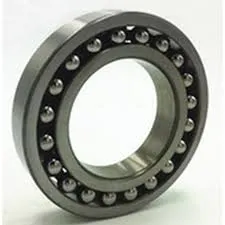
9 月 . 19, 2024 22:38 Back to list
thrust bearing and radial bearing
Understanding Thrust Bearings and Radial Bearings
Bearings are essential components in machinery, responsible for supporting loads and enabling smooth motion between moving parts. Among the various types of bearings, thrust bearings and radial bearings play crucial roles in ensuring efficient operation in many applications. This article explores their functions, differences, and applications.
Thrust Bearings
Thrust bearings are specifically designed to handle axial loads, which are forces that act parallel to the axis of rotation. These bearings are essential in applications where machinery experiences significant thrust, such as in automotive transmissions, marine propulsion systems, and heavy machinery. Thrust bearings can be classified into various types, including ball thrust bearings, roller thrust bearings, and fluid thrust bearings.
Ball thrust bearings consist of balls positioned between two flat surfaces. This design allows them to accommodate a limited level of misalignment and offers reduced friction. Roller thrust bearings, on the other hand, use cylindrical rollers, providing better load capacity and lower friction than their ball counterparts. Fluid thrust bearings utilize a thin film of liquid to support the load, providing virtually frictionless operation in certain high-performance applications.
thrust bearing and radial bearing

Radial Bearings
Unlike thrust bearings, radial bearings are designed to support loads that act perpendicular to the axis of rotation. They are commonly used in applications such as electric motors, pumps, and gearboxes. The most common type of radial bearing is the deep groove ball bearing, which features a continuous groove that can accommodate both radial and axial loads.
Other types of radial bearings include cylindrical roller bearings and spherical roller bearings. Cylindrical roller bearings are known for their ability to carry heavy radial loads, while spherical roller bearings can handle some axial load due to their unique geometry. The main advantage of radial bearings is their ability to maintain smooth rotation and minimize wear over time, which is essential for the longevity of machinery.
Conclusion
In summary, thrust bearings and radial bearings serve distinct yet vital roles in various mechanical systems. While thrust bearings focus on managing axial loads, radial bearings are adept at handling radial loads. Understanding the differences between these two types of bearings allows engineers and technicians to select the appropriate bearing for specific applications, leading to improved performance and longevity of machinery. Whether in automotive, industrial, or aerospace applications, the proper use of thrust and radial bearings is fundamental to operational efficiency and reliability.
Latest news
-
Unlocking Efficiency with Spherical Roller Bearings
NewsOct.29,2024
-
The Ultimate Guide to Thrust Ball Bearings
NewsOct.29,2024
-
The Power of Thrust Roller Bearings: Engineered for Excellence
NewsOct.29,2024
-
The Power of Deep Groove Ball Bearings for Your Application Needs!
NewsOct.29,2024
-
The Power and Performance of Cylindrical Roller Bearings
NewsOct.29,2024
-
High-Quality Ball Bearing Manufacturing Machines
NewsOct.29,2024
